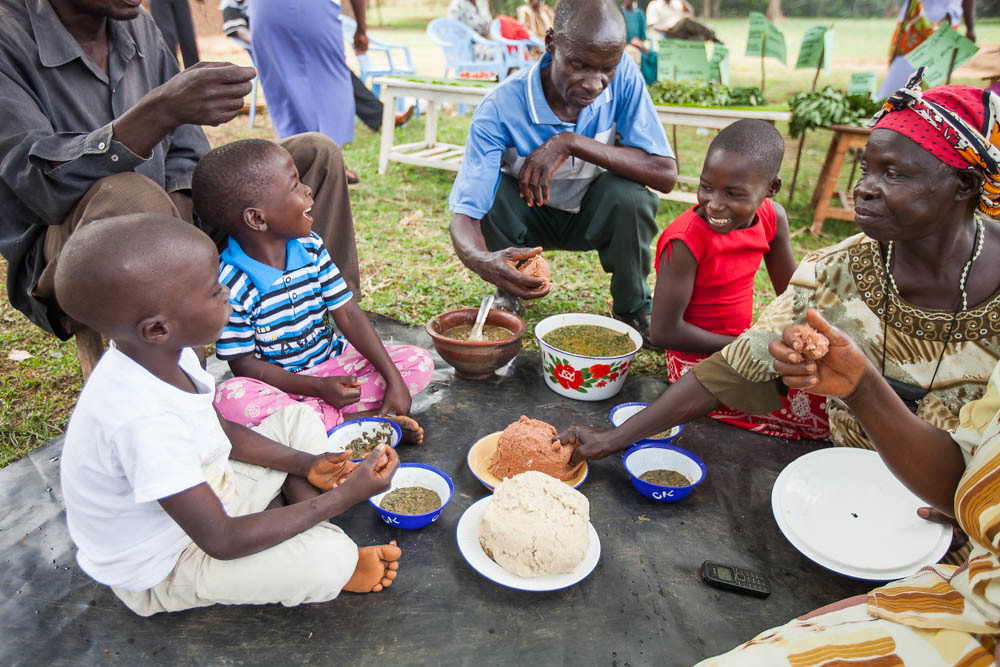Quality social and behavior change (SBC) is the thread that ties nutrition sectors and strategies together for improved nutrition. Whether an activity aims to improve the nutritional status of women and children, foster more resilient communities, or increase the availability of safe, affordable, and nutritious foods, individual behaviors are at the heart of the solution.
Most nutrition programs intend to use quality SBC approaches, but key steps are often missed. Nutrition SBC is particularly challenging due to the nature of the behaviors—small, frequent, and additive.
Keep scrolling to learn about the six steps in high-quality SBC programming and access practical tools for each step.

Step 1: Prioritize Behaviors
No matter how skilled a program’s SBC team is, no program can do everything. Behavior prioritization is the first step in nutrition program design. It leads programmers to focus efforts and activities on the outcomes that will have the greatest impact on the nutrition goal.
Step 1: Prioritize Behaviors
No matter how skilled a program’s SBC team is, no program can do everything. Behavior prioritization is the first step in nutrition program design. It leads programmers to focus efforts and activities on the outcomes that will have the greatest impact on the nutrition goal.

Prioritizing Multi-Sectoral Nutrition Behaviors
Apply a simple step-by-step process to prioritize which nutrition behaviors will have the greatest impact and avoid overwhelming people.

Behaviors to Improve Nutrition
Learn about the six core nutrition-specific behaviors that research shows will lead to improved nutrition outcomes.
Illustrative Behaviors to Improve Nutrition-Sensitive Agriculture
Use this resource to spark discussion to prioritize behaviors that can improve nutrition through agriculture programming.

Step 2: Plan and Conduct Research
To improve behaviors, it is key to understand the main barriers and enablers or “factors” that may prevent or support individuals to practice a behavior. Explore the literature on the possible factors that influence someone to practice and maintain nutrition-related behaviors. Then select formative research methods to answer research questions from gaps in the literature to better understand people and their context.
Step 2: Plan and Conduct Research
To improve behaviors, it is key to understand the main barriers and enablers or “factors” that may prevent or support individuals to practice a behavior. Explore the literature on the possible factors that influence someone to practice and maintain nutrition-related behaviors. Then select formative research methods to answer research questions from gaps in the literature to better understand people and their context.
Factors That Influence Multi-Sectoral Nutrition Behaviors
Use this tool to consider the possible factors that prevent or support people to practice nutrition-related behaviors.
SBC Formative Research Decision Tree
This tool guides users through three steps to selecting research methods that will help them answer research questions to understand “why” systems, services, networks, and other factors influence people’s behaviors and “how” to support participant-led improvements.

Step 3: Design a Nutrition Social and Behavior Change Strategy
After you prioritize behaviors and conduct formative research, use the tools below to design, assess, and strengthen your SBC strategy. An SBC strategy provides a roadmap to ensure that interventions address the critical factors that will improve the priority nutrition behaviors. A strong SBC strategy is the foundation for implementing, monitoring, and evaluating programs for impact.
Explore examples of nutrition SBC strategies:
Step 3: Design a Nutrition Social and Behavior Change Strategy
After you prioritize behaviors and conduct formative research, use the tools below to design, assess, and strengthen your SBC strategy. An SBC strategy provides a roadmap to ensure that interventions address the critical factors that will improve the priority nutrition behaviors. A strong SBC strategy is the foundation for implementing, monitoring, and evaluating programs for impact.
Explore examples of nutrition SBC strategies:

Using Research to Design a SBC Strategy
Use this resource to organize research into an evidence-based SBC strategy. Research findings can be challenging to distill and apply to programs; this framework offers a manageable, step-by-step process.

Nutrition SBC Strategy Checklist
Use this checklist to prepare a new SBC strategy or assess a completed strategy to ensure core elements are covered.

Step 4: Plan for Implementation and Monitoring, Evaluation, and Learning
Plan for quality SBC implementation and monitoring with a work plan checklist. Use the resources below to learn more about capacity strengthening for program staff and frontline health workers to implement SBC programs. Integrate gender considerations into implementation plans, both women's empowerment and family engagement to create a more enabling environment for nutrition.
Step 4: Plan for Implementation and Monitoring, Evaluation, and Learning
Plan for quality SBC implementation and monitoring with a work plan checklist. Use the resources below to learn more about capacity strengthening for program staff and frontline health workers to implement SBC programs. Integrate gender considerations into implementation plans, both women's empowerment and family engagement to create a more enabling environment for nutrition.

Nutrition SBC Work Plan Checklist
Use this checklist to consider SBC content to include in an annual work plan or assess a draft work plan.

Defining SBC Competencies for Multi-Sectoral Nutrition List
This tool identifies SBC competencies that program staff need. Use this resource to guide hiring decisions, identify areas for capacity strengthening, and track changes in performance over time.
Community Health Worker Competency List for Nutrition Social and Behavior Change
A concise look at the core competencies to help plan capacity strengthening activities for community health workers and others on the frontline.

Integrating Gender into Nutrition Programs: Program Guide
Gender dynamics underlie nutrition-related behaviors and norms; responding to these dynamics in each local context is critical to improving nutrition outcomes. This guide provides resources and examples to integrate gender at each phase of a nutrition program.

Step 5: Implement, Monitor, and Adapt
Implementation of SBC is just as important as high-quality design for nutrition outcomes. Improving the quality of activities to achieve social and behavior change at every stage means using good implementation practices and monitoring while adjusting carefully at regular intervals. In order to make timely adjustments to programs, it is critical to monitor changes in identified nutrition-related behaviors and including the factors that may prevent or support behavior change.
Step 5: Implement, Monitor, and Adapt
Implementation of SBC is just as important as high-quality design for nutrition outcomes. Improving the quality of activities to achieve social and behavior change at every stage means using good implementation practices and monitoring while adjusting carefully at regular intervals. In order to make timely adjustments to programs, it is critical to monitor changes in identified nutrition-related behaviors and including the factors that may prevent or support behavior change.
Social and Behavior Change Do's and Don'ts: Getting It Right for Multi-Sectoral Nutrition Programming
This resource offers reminders of good implementation practices and problems to avoid. Identify areas to check and adjust as needed to improve quality at every stage.

Monitoring Social and Behavior Change for Multi-Sectoral Nutrition
Learn how to identify appropriate indicators, select and apply methods, analyze results, and make adaptations during program design and implementation.

Focusing on Social Norms: A Practical Guide for Nutrition Programmers to Improve Women’s and Children’s Diets
Social norms influence the meaning and value of food as well as roles and expectations people bring to food choices. This guide helps programs understand social norms and develop responsive activities to improve nutrition outcomes.

Step 6: Evaluate
Evaluations that are carefully designed and conducted can help nutrition SBC programmers identify what worked well, what could have been done differently, and how to design and implement future programs for improved nutrition outcomes.
Step 6: Evaluate
Evaluations that are carefully designed and conducted can help nutrition SBC programmers identify what worked well, what could have been done differently, and how to design and implement future programs for improved nutrition outcomes.

Evaluating Social and Behavior Change Components of Nutrition Activities: A Design Guide for USAID Staff
USAID staff can use this guide to plan and implement evaluations for SBC activities. Evaluations that are carefully designed and conducted to capture several key elements of SBC are useful to all decision makers.
Measuring Social and Behavior Change in Nutrition Programs: A Guide for Evaluators
Implementing partners can use this resource to manage an evaluation that demonstrates progress toward goals. As SBC is common in most USAID-funded activities, USAID and implementers rely on well-designed program evaluations to determine which approaches and processes are most effective and why.

How These Six Steps for High-Quality SBC Programming Fit Together
The Enabling Complementary Feeding: Guidance and Workbook can show you how all of these steps fit together, leading to high-quality nutrition SBC interventions. Use this web page to explore key concepts of behavior-centered programming to improve nutrition outcomes, with complementary feeding as your case study example.
Explore the Enabling Complementary Feeding: Guidance and Workbook (English) or Workbook only (French)
How These Six Steps for High-Quality SBC Programming Fit Together
The Enabling Complementary Feeding: Guidance and Workbook can show you how all of these steps fit together, leading to high-quality nutrition SBC interventions. Use this web page to explore key concepts of behavior-centered programming to improve nutrition outcomes, with complementary feeding as your case study example.
Explore the Enabling Complementary Feeding: Guidance and Workbook (English) or Workbook only (French)
